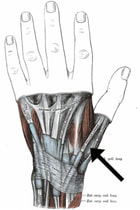DeQUERVAIN’S SYNDROME
CAUSES AND SOLUTIONS
|
“The management of de Quervain’s disease is determined more by convention than scientific data. From the original description of the illness in 1895 until the first description of corticosteroid injection by Jarrod Ismond in 1955, it appears that the only treatment offered was surgery. Since approximately 1972 the prevailing opinion has been that of McKenzie who suggested that corticosteroid injection was the first line of treatment and surgery should be reserved for unsuccessful injections. A systematic review and meta-analysis published in 2013 found that corticosteroid injection seems to be an effective form of conservative management of de Quervain’s syndrome in approximately 50% of patients, although more research is needed regarding the extent of any [long term] clinical benefits.” – Wikipedia, quoting from half a dozen scientific studies (1955 to 2013) from peer-reviewed journals.
|
- Pain at the Thumb Side of the Wrist
- Tenderness to the Touch in the Same Area
- Swelling Over the Thumb Side of the Wrist
- Difficulty Gripping Things or Opposing your Thumb (Pinching)
Even more interesting is that the two forms of treatment that the peer-reviewed literature discuss the most for DeQuervain’s Syndrome (CORTICOSTEROID INJECTIONS and Surgery) are not any too effective. Case in point: just re-read the quote at the top of the page. Likewise, the same scientific literature considers NSAIDS to be ‘palliative‘ as opposed to therapeutic (they have the potential to help you feel better, but do nothing to actually help you get better). In looking at the studies concerning treatment for DeQuervin’s Syndrome, you will see lists of other treatment methods (besides Corticosteroid Injections or Surgery) that one might use to deal this this problem, and call them “experimental” (COLD LASER THERAPY is on this list). But then again, what can you expect from EVIDENCE-BASED MEDICINE. As you may have noticed, drugs and surgery rule the day — it’s where the biggest money is. As we already learned from the quote at the top of the page; just like so many other health problems (HERE), treatment protocols are determined not by “scientific data” but instead by “convention” (tradition). GREAT RESULTS cannot be faked!
I would suggest that if you think you think you might have this problem, take a long look at my site’s DeQUERVAIN’S SYNDROME PAGE. I promise that you’ll learn far more than your doctor ever thought about telling you (including information on making the diagnosis yourself —- it takes all of two seconds).

